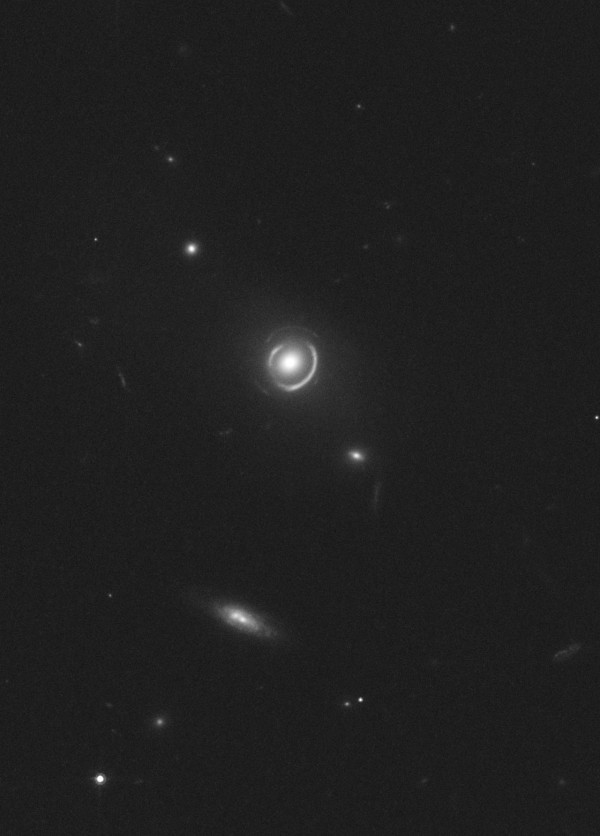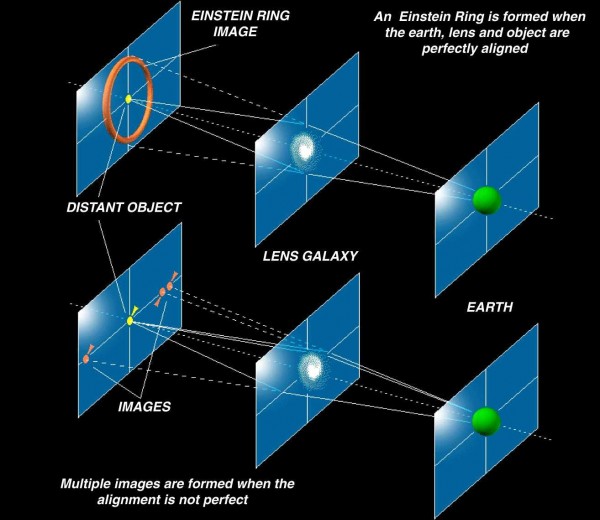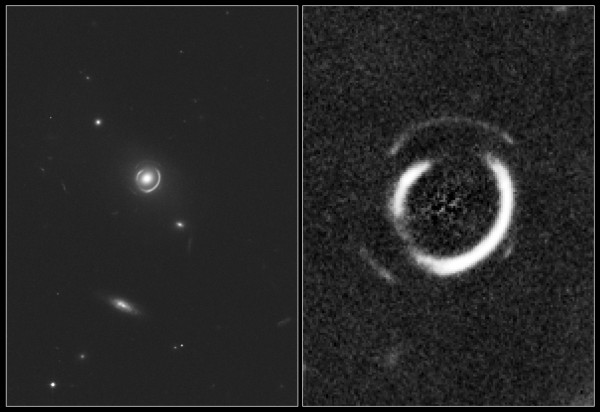One of the perks of being a postdoc at a place like the University of Arizona, one of the top places in the US for astronomy, is that we get a number of really interesting visitors. Today we got paid a visit by Tommaso Treu, an astronomer at UC Santa Barbara.
He spoke to us today about one of his most recent, most interesting discoveries, done with the Hubble Space Telescope, of a double Einstein Ring. Take a look at the image below:
You'll notice that there's a ball of light in the center with some ring-like structure(s) around it. These things are rare, first off. There are only two ways that we know of to make something that looks like a ring in space:
- When a galaxy is being gravitationally captured by another galaxy, tidal forces can cause the captured galaxy to stretch apart into a ring around the larger galaxy. There are other gravitational methods of creating a ring (e.g., the rings around Saturn), but they don't operate on scales as large as a galaxy. In these cases, the ring and the galaxy will be roughly the same distance away from us.
- The galaxies can be perfectly lined up with our own, making a three-in-a-row alignment. The galaxy farthest from us will be "lensed" by the one in the middle; the gravity from the intervening galaxy will bend the light into a ring if the alignment is perfect. This illustration shows how it happens:
In this case, the central galaxy and the ring around it will be at significantly different distances from one another.
So how can we tell which one is going on? We can tell whether the ring is part of the galaxy or whether it's an Einstein Ring by measuring the redshifts (and hence the distances) of these objects. Let's zoom in for a closer look and block the light from the central galaxy with a filter, and see what we can learn:
Do you see how there's not just one ring around the galaxy, but a fainter set of arcs in a ring-shape outside of it? This means that there aren't two galaxies aligned with our own, but THREE, where the foreground galaxy is about 900 Megaparsecs from us, the "inner ring" is a galaxy about 1800 Megaparsecs away, and the "outer ring" is a galaxy about 3300 Megaparsecs away. (Remember that a Megaparsec is about 3.3 million light-years!) If it weren't for the foreground galaxy, which not only stretches but magnifies those in back of it, we'd never see those background galaxies at all, because they're small and faint, and so far away!
This alignment is so rare that it's estimated there are less than 100 of these in the entire universe, and we just found one! (In fact, it's very unlikely that there is even one "triple Einstein ring" in the entire universe.) What's more, is that we can use these lenses, which are sensitive to the total mass of the objects, to learn about the dark matter in the galaxies; again, this is more evidence that is consistent with dark matter and inconsistent with modified gravity. In any case, this is rare and exciting stuff, and makes me excited that we still have the Hubble space telescope!
- Log in to post comments




All of this information is completely incredible! I'm only 18 years old but I want to know all of this information and try to test my own hypothesis some day. Thanks for your time and efforts and knowladge put into these posts Ethan! I'm so inspired to go to college and learn astronomy!
Double Einstein ring? All the way across the sky?